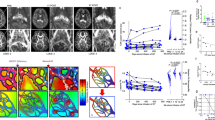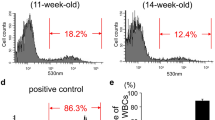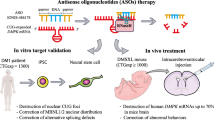Abstract
X-linked adrenoleukodystrophy (ALD) is a genetic disorder of the ABCD1 gene. We aimed to treat ALD via direct intracerebral injection of lentiviral ABCD1 (LV.ABCD1). Lentiviral vectors (LVs) were injected into the brain of wild type mice to access toxicities and biodistribution. Confocal microscopy illustrated supraphysiological ABCD1 expression surrounding the injection sites, and LVs were also detected in the opposite site of the unilaterally injected brain. In multi-site bilateral injections (4, 6, 8, and 9 sites), LV.ABCD1 transduced most brain regions including the cerebellum. Investigation of neuronal loss, astrogliosis and microglia activation did not detect abnormality. For efficacy evaluation, a novel ALD knockout (KO) mouse model was established by deleting exons 3 to 9 of the ABCD1 gene based on CRISPR/Cas9 gene editing. The KO mice showed behavioral deficit in open-field test (OFT) and reduced locomotor activities in rotarod test at 6 and 7 months of age, respectively. We treated 3-month-old KO mice with bilateral LV.ABCD1 injections into the external capsule and thalamus. ABCD1 expression was detected 15 days later, and the impaired motor ability was gradually alleviated. Our studies established an early onset ALD model and illustrated neurological improvement after LV.ABCD1 intracerebral injection without immunopathological toxicity.
This is a preview of subscription content, access via your institution
Access options
Subscribe to this journal
Receive 12 print issues and online access
$259.00 per year
only $21.58 per issue
Buy this article
- Purchase on Springer Link
- Instant access to full article PDF
Prices may be subject to local taxes which are calculated during checkout






Similar content being viewed by others
Data availability
All raw data and materials used for figure generation in this study are available by contacting the corresponding author.
References
Raymond GV. Leukodystrophy: basic and clinical. Adv Neurobiol. 2017;15:365–82.
Deon M, Marchetti DP, Donida B, Wajner M, Vargas C. Oxidative stress in patients with X-linked adrenoleukodystrophy. Cell Mol Neurobiol. 2015;36:497–512.
Ohashi T. Gene therapy for lysosomal storage diseases and peroxisomal diseases. J Hum Genet. 2018;64:139–43.
Powers JM, Pei Z, Heinzer AK, Deering R, Moser AB, Moser HW, et al. Adreno-leukodystrophy: oxidative stress of mice and men. J Neuropathol Exp Neurol. 2005;64:1067–79.
Jia MR, Wu WZ, Li CM, Cai XH, Zhang L, Yan F, et al. Clinical characteristics and phenotype distribution in 10 chinese patients with X-linked adrenoleukodystrophy. Exp Ther Med. 2019;18:1945–52.
Kemp S, Berger J, Aubourg P. X-linked adrenoleukodystrophy: Clinical, metabolic, genetic and pathophysiological aspects. Biochim Biophys Acta. 2012;1822:1465–74.
Sassa T, Wakashima T, Ohno Y, Kihara A. Lorenzo’s oil inhibits ELOVL1 and lowers the level of sphingomyelin with a saturated very long-chain fatty acid. J Lipid Res. 2014;55:524–30.
Ciftciler R, Goker H, Buyukasik Y, Topcu M, Gevher N, Demiroglu H. The experience of allogeneic hematopoietic stem cell transplantation in a patient with X-linked adrenoleukodystrophy. Transfus Apher Sci. 2020;59:102583.
Mallack EJ, Turk B, Yan H, Eichler FS. The landscape of hematopoietic stem cell transplant and gene therapy for X-linked adrenoleukodystrophy. Curr Treat Options Neurol. 2019;21:61.
Thwaite R, Pagès G, Chillón M, Bosch A. AAVrh.10 immunogenicity in mice and humans. Relevance of antibody cross-reactivity in human gene therapy. Gene Ther. 2014;22:196–201.
Zhao L, Gottesdiener AJ, Parmar M, Li M, Kaminsky SM, Chiuchiolo MJ, et al. Intracerebral adeno-associated virus gene delivery of apolipoprotein E2 markedly reduces brain amyloid pathology in Alzheimer’s disease mouse models. Neurobiol Aging. 2016;44:159–72.
Tardieu M, Zérah M, Gougeon M-L, Ausseil J, de Bournonville S, Husson B, et al. Intracerebral gene therapy in children with mucopolysaccharidosis type IIIb syndrome: an uncontrolled phase 1/2 clinical trial. Lancet Neurol. 2017;16:712–20.
Russell KN, Mitchell NL, Anderson NG, Bunt CR, Wellby MP, Melzer TR, et al. Computed tomography provides enhanced techniques for longitudinal monitoring of progressive intracranial volume loss associated with regional neurodegeneration in ovine neuronal ceroid lipofuscinoses. Brain Behav. 2018;8:e01096.
Chien Y-H, Lee N-C, Tseng S-H, Tai C-H, Muramatsu S-I, Byrne BJ, et al. Efficacy and safety of AAV2 gene therapy in children with aromatic L-amino acid decarboxylase deficiency: an open-label, phase 1/2 trial. Lancet Child Adoles Health. 2017;1:265–73.
Naso MF, Tomkowicz B, Perry WL 3rd, Strohl WR. Adeno-associated virus (AAV) as a vector for gene therapy. BioDrugs. 2017;31:317–34.
Chang L-J, Urlacher V, Iwakuma T, Cui Y, Zucali J. Efficacy and safety analyses of a recombinant human immunodeficiency virus type 1 derived vector system. Gene Ther. 1999;6:715–28.
Chang L-J, Gay EE. The molecular genetics of lentiviral vectors - current and future perspectives. Curr Gene Ther. 2001;1:237–51.
Engelen M, Kemp S, Poll-The BT. X-linked adrenoleukodystrophy: Pathogenesis and treatment. Curr Neurol Neurosci Rep. 2014;14:486.
Eichler F, Duncan C, Musolino PL, Orchard PJ, De Oliveira S, Thrasher AJ, et al. Hematopoietic stem-cell gene therapy for cerebral adrenoleukodystrophy. N Engl J Med. 2017;377:1630–8.
Nathalie Cartier SH-B-A. Hematopoietic stem cell gene therapy with a lentiviral vector in X-linked adrenoleukodystrophy. Science. 2009;326:818–23.
Palfi S, Gurruchaga JM, Ralph GS, Lepetit H, Lavisse S, Buttery PC, et al. Long-term safety and tolerability of prosavin, a lentiviral vector-based gene therapy for Parkinson’s disease: a dose escalation, open-label, phase 1/2 trial. Lancet. 2014;383:1138–46.
Meneghini V, Lattanzi A, Tiradani L, Bravo G, Morena F, Sanvito F, et al. Pervasive supply of therapeutic lysosomal enzymes in the CNS of normal and Krabbe-affected non-human primates by intracerebral lentiviral gene therapy. EMBO Mol Med. 2016;8:489–510.
Chang L-J, Liu X, He J. Lentiviral siRNAs targeting multiple highly conserved RNA sequences of human immunodeficiency virus type 1. Gene Ther. 2005;12:1133–44.
Gong J, Chung T-H, Zheng J, Zheng H, Chang L-J. Transduction of modified factor VIII gene improves lentiviral gene therapy efficacy for hemophilia A. J Biol Chem. 2021;297:101397.
Vowells SJ, Sekhsaria S, Malech HL, Shalit M, Fleisher TA. Flow cytometric analysis of the granulocyte respiratory burst: a comparison study of fluorescent probes. J Immunol Meth. 1995;178:89–97.
Pujol A, Hindelang C, Callizot N, Bartsch U, Schachner M, Mandel JL. Late onset neurological phenotype of the X-ALD gene inactivation in mice: a mouse model for adrenomyeloneuropathy. Hum Mol Genet. 2002;11:499–505.
Lu JF, Lawler AM, Watkins PA, Powers JM, Moser AB, Moser HW, et al. A mouse model for X-linked adrenoleukodystrophy. Proc Natl Acad Sci USA. 1997;94:9366–71.
Kobayashi T, Shinnoh N, Kondo A, Yamada T. Adrenoleukodystrophy protein-deficient mice represent abnormality of very long chain fatty acid metabolism. Bioch and Biophys Res Comm. 1997;232:5.
Turk BR, Theda C, Fatemi A, Moser AB. X-linked adrenoleukodystrophy: pathology, pathophysiology, diagnostic testing, newborn screening and therapies. Int J Dev Neurosci. 2020;80:52–72.
Igarashi M, Schaumburg HH, Powers J, Kishmoto Y, Kolodny E, Suzuki K. Fatty acid abnormality in adrenoleukodystrophy. J Neurochem. 1976;26:851–60.
Vargas CR, Wajner M, Sirtori LR, Goulart L, Chiochetta M, Coelho D, et al. Evidence that oxidative stress is increased in patients with X-linked adrenoleukodystrophy. Biochim Biophys Acta. 2004;1688:26–32.
Uto T, Contreras MA, Gilg AG, Singh I. Oxidative imbalance in nonstimulated X-adrenoleukodystrophy-derived lymphoblasts. Dev Neurosci. 2008;30:410–8.
Di Biase A, Di Benedetto R, Fiorentini C, Travaglione S, Salvati S, Attorri L, et al. Free radical release in C6 glial cells enriched in hexacosanoic acid: Implication for X-linked adrenoleukodystrophy pathogenesis. Neurochem Int. 2004;44:215–21.
Hocquemiller M, Giersch L, Audrain M, Parker S, Cartier N. Adeno-associated virus-based gene therapy for CNS diseases. Hum Gene Ther. 2016;27:478–96.
Chen Y, Zheng S, Tecedor L, Davidson BL. Overcoming limitations inherent in sulfamidase to improve mucopolysaccharidosis IIIa gene therapy. Mol Ther. 2018;26:1118–26.
Fu H, Meadows AS, Ware T, Mohney RP, McCarty DM. Near-complete correction of profound metabolomic impairments corresponding to functional benefit in MPS IIIb mice after IV rAAV9-hNAGLU gene delivery. Mol Ther. 2017;25:792–802.
Tardieu M, Zerah M, Husson B, de Bournonville S, Deiva K, Adamsbaum C, et al. Intracerebral administration of adeno-associated viral vector serotype rh.10 carrying human SGSH and SUMF1 cDNAs in children with mucopolysaccharidosis type IIIa disease: results of a phase I/II trial. Hum Gene Ther. 2014;25:506–16.
Liu W, Zhao L, Blackman B, Parmar M, Wong MY, Woo T, et al. Vectored intracerebral immunization with the anti-Tau monoclonal antibody PHF1 markedly reduces Tau pathology in mutant Tau transgenic mice. J Neurosci. 2016;36:12425–35.
McIntyre C, Derrick-Roberts ALK, Byers S, Anson DS. Correction of murine mucopolysaccharidosis type IIIa central nervous system pathology by intracerebroventricular lentiviral-mediated gene delivery. J Gene Med. 2014;16:374–87.
Lattanzi A, Salvagno C, Maderna C, Benedicenti F, Morena F, Kulik W, et al. Therapeutic benefit of lentiviral-mediated neonatal intracerebral gene therapy in a mouse model of globoid cell leukodystrophy. Hum Mol Genet. 2014;23:3250–68.
Mandel RJ, Burger C, Snyder RO. Viral vectors for in vivo gene transfer in Parkinson’s disease: Properties and clinical grade production. Exp Neurol. 2008;209:58–71.
Choudhury SR, Hudry E, Maguire CA, Sena-Esteves M, Breakefield XO, Grandi P. Viral vectors for therapy of neurologic diseases. Neuropharmacology. 2017;120:63–80.
Low K, Aebischer P. Use of viral vectors to create animal models for Parkinson’s disease. Neurobiol Dis. 2012;48:189–201.
Ingusci S, Verlengia G, Soukupova M, Zucchini S, Simonato M. Gene therapy tools for brain diseases. Front Pharmacol. 2019;10:724.
Gong Y, Mu D, Prabhakar S, Moser A, Musolino P, Ren J, et al. Adenoassociated virus serotype 9-mediated gene therapy for X-linked adrenoleukodystrophy. Mol Ther. 2015;23:824–34.
Koziol LF, Budding D, Andreasen N, D’Arrigo S, Bulgheroni S, Imamizu H, et al. Consensus paper: the cerebellum’s role in movement and cognition. Cerebellum (London, England). 2014;13:151–77.
Samson M, Claassen DO. Neurodegeneration and the cerebellum. Neurodegener Dis. 2017;17:155–65.
Ribera A, Haurigot V, Garcia M, Marco S, Motas S, Villacampa P, et al. Biochemical, histological and functional correction of mucopolysaccharidosis type IIIb by intra-cerebrospinal fluid gene therapy. Hum Mol Genet. 2015;24:2078–95.
Chu BB, Liao YC, Qi W, Xie C, Du X, Wang J, et al. Cholesterol transport through lysosome-peroxisome membrane contacts. Cell. 2015;161:291–306.
Casasnovas C, Ruiz M, Schluter A, Naudi A, Fourcade S, Veciana M, et al. Biomarker identification, safety, and efficacy of high-dose antioxidants for adrenomyeloneuropathy: A phase II pilot study. Neurotherapeutics. 2019;16:1167–82.
Gong Y, Berenson A, Laheji F, Gao G, Wang D, Ng C, et al. Intrathecal adeno-associated viral vector-mediated gene delivery for adrenomyeloneuropathy. Hum Gene Ther. 2019;30:544–55.
Acknowledgements
The authors thank all members of the UESTC and GIMI teams for their participation in discussion and laboratory support.
Funding
This study was funded by China Postdoctoral Science Foundation Grant (No.2018M643439) to THC, Foundation for Introduction and Training of Outstanding Scholarship of the National “985” Project (Project 985: A1098531023601102), The Fundamental Research Funds for the Central Universities (ZYGX2016Z009), and Science and Technology Planning Technical Research Project of Shenzhen (JCYJ20160229170523065 and KQTD20140630143254906).
Author information
Authors and Affiliations
Contributions
LJC and THC conceptualized, supervised, and administered the investigation; LJC engineered and constructed the lentiviral vectors; JG, YYL, THC, and LX developed the methodologies; visualization was done by JG, YYL, THC, and LX; LJC and THC acquired the funding; JG, YYL, and THC drafted and LJC and TCL revised the manuscript; all participated in discussion, reviewed and approved the final manuscript.
Corresponding author
Ethics declarations
Competing interests
The authors declare no competing interests.
Additional information
Publisher’s note Springer Nature remains neutral with regard to jurisdictional claims in published maps and institutional affiliations.
Supplementary information
Rights and permissions
About this article
Cite this article
Gong, J., Liu, Y., Chung, TH. et al. Intracerebral lentiviral ABCD1 gene therapy in an early disease onset ALD mouse model. Gene Ther 30, 18–30 (2023). https://doi.org/10.1038/s41434-022-00355-0
Received:
Revised:
Accepted:
Published:
Issue Date:
DOI: https://doi.org/10.1038/s41434-022-00355-0



